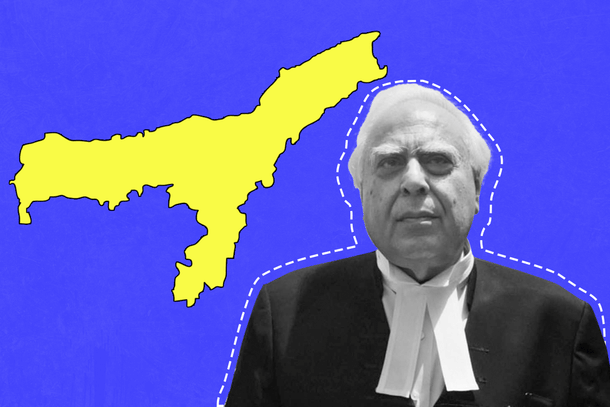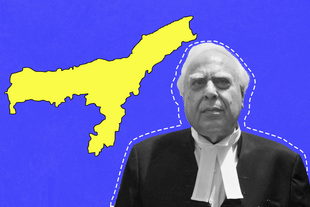Politics
A 'History 101' For Those Who Think Assam Was Ever A Part Of Myanmar
Nabaarun Barooah
Dec 11, 2023, 04:19 PM | Updated 04:19 PM IST
Save & read from anywhere!
Bookmark stories for easy access on any device or the Swarajya app.


On 5 December 2023, senior advocate and politician Kapil Sibal remarked from the floor of the Supreme Court of India that Assam was a part of Myanmar, and was later conquered by the British and joined with the Indian Union.
These comments are not only historically inaccurate but also offensive to Assamese sentiments. This article is an 'Assam History 101' for the likes of Sibal whose political perspectives have overlooked the North East in the broader context of the Indian nation.
The Origins Of Assam
The origins of Assam are in fact deeply rooted in not just the Indian nation but also Hindu civilisation. The Ashwamedha Parva of the Mahabharata, mentions Pragjyotisha (identified with Guwahati) as the kingdom of Bhagadatta, the son of Narakasura.
In fact, the capital of Pragjyotishpura (modern-day Guwahati) is said to be established by Narakasura. The hillock on which he was believed to be seated exists even today in the heart of Guwahati and is called Narakasura Hill.
According to a belief, Naraka was a contemporary of Banasura who ruled from Sonitpur, Assam, who is also mentioned in the ancient epic. All important dynasties of ancient Assam such as the Varmans claimed descent from Narakasura himself. Other important scriptures which have described this dynasty include the Bhagavat Purana and the Vishnu Purana.
The story of Naraka and his desire to marry goddess Kamakhya also finds prominence in other scriptures that originated from around Assam, which include the Kalika Purana and the Yogini Tantra. These are two extensive treatises on not just the history of ancient Assam but also on the Kaula marga of Tantra sadhana.
These scriptures continue to be the most pivotal texts of Tantric literature followed even today in Kamakhya Kshetram in Nilachal. The ancient hill is the abode of goddess Kamakhya and the 10 mahavidyas of Hindu dharma, making it the centre of Tantra worship in the country.
The Kalika Purana also elaborately describes the extent of the Kamarupa empire, which stretched from Cooch Behar to Tamreshwari Temple in Sadiya. The Yogini Tantra draws the empire from northern Bengal to Saumarapitha at the Dikrai river.
All important Hindu religious scriptures are quite clear about the origins of Assam. Even political treatises such as Kautilya’s Arthashastra mentions this region as Lohitya (named after the river Lohit), while Samudragupta’s inscription at Allahabad explicitly mentions Kamarupa and Dabaka (near Nagaon) as his contemporary kingdoms.
If historical evidence is clear on the origins of Kamarupa-Pragjyotisha, then how come Assam is claimed to be a part of Myanmar?
Manor Din — The Burmese Invasion Of Assam
In the early decades of the nineteenth century, Ahom rule had considerably declined due to the Moamoria Revolt led by the Matak chieftains. Weakened Ahom rule left Assam and Manipur vulnerable to raids and invasions led by the Konbaung Empire or Third Burmese Empire. During these tumultuous decades, parts of the Ahom kingdom came to be ruled by the Konbaung regime from 1821 to 1825.
The colloquial term ‘Manor Din’ or days of the Man (Burmese) is alive even today in Assamese popular memory as a period of horror that nearly halved the population of Assam. This period was marked by an ethnic cleansing of the indigenous population and crimes against women and children.
In the early days of the invasion, for example, nearly 50 men were decapitated and 200 more were torched to flames on the banks of the Kolong river. During Burmese rule, several Naamghars or centres of neo-Vaishnavite religion were desecrated and Brahmins forced to carry beef.
Prominent Assamese freedom fighter Maniram Dewan, in his memoirs, details the sexual crimes committed by Burmese troops on Assamese women.
Such atrocities were also repeated in Manipur where the Meitei civilisation came to near-extinction due to the barbarity of the Konbaung army. Only in 1825 did the Meiteis launch a successful campaign to drive the Burmese out. This later culminating in the British entering the battlefield and signing the Treaty of Yandaboo in 1826, formally gaining Assam and Manipur as additions to the British Empire in India.
What Sibal Forgot
Burmese rule in the North East marked the most horrific decades of Assamese and Manipuri history. These days continue to remain a blot in our collective memory even today.
When senior national leaders such as Kapil Sibal disregard centuries of indigenous history and glorify the genocidal rule of foreign tyrants, it undermines the combined efforts of successive generations to keep our history alive.
Such uninformed remarks made at a national stage are a reflection of one’s ignorance towards their own fellow countrymen.
More importantly, it suggests a prejudice against the North East as a site of the “Mongolian fringe”.
Those who ruled the North East with impunity for nearly 70 years continue to view the region as the ‘other’ even after 75 years of Independence.
Nabaarun Barooah is an author and commentator.





